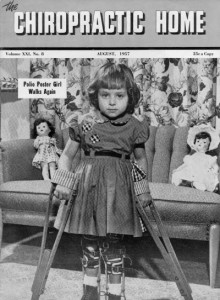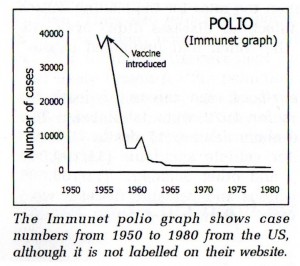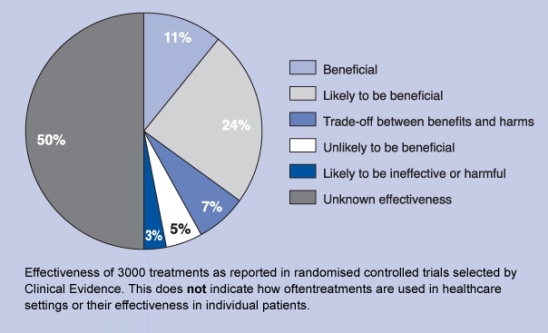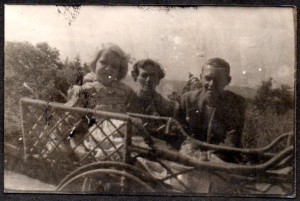 This is not a case of “chiropractic cures polio”. This is a historical perspective on disease and prevention.
This is not a case of “chiropractic cures polio”. This is a historical perspective on disease and prevention.
During the 1900s there was a global decline in death rates from all major infectious disease (typhoid, smallpox, scarlet fever, measles, whooping cough, diptheria, influenza, tuberculosis, pneumonia, diseases of the digestive system and poliomyelitis) due to improvements in environmental sanitation, particularly water purification and sewage disposal; better housing, clothing and nutrition.
In the late 20th century, children whose living standards were poor were more susceptible to infectious diseases than their more advantaged peers. We see this disparity today between first and third world countries.
The subject of vaccination and preventable disease is a loaded topic because the decline in death from infectious disease began long before the introduction of any prophylaxis or “preventative medicine”, plus data can be viewed at different angles depending on the researcher’s bias.
 In 1955, a graph from the Immunet website showed 40,000 cases of polio in NZ when in fact there were only 703 cases1. At first glance, the polio graph shows a dramatic decrease in the incidence of polio immediately following the introduction of the Salk vaccine, however, the data is not actually from NZ. It’s from the United States. The peak incidence of polio in NZ only ever reached 1159 in 1925. The provision of this data to New Zealanders without specifying the country of origin was tantamount to scaremongering.
In 1955, a graph from the Immunet website showed 40,000 cases of polio in NZ when in fact there were only 703 cases1. At first glance, the polio graph shows a dramatic decrease in the incidence of polio immediately following the introduction of the Salk vaccine, however, the data is not actually from NZ. It’s from the United States. The peak incidence of polio in NZ only ever reached 1159 in 1925. The provision of this data to New Zealanders without specifying the country of origin was tantamount to scaremongering.
This tactic has been used again and again. In recent times we recall the MeNZB (meningococcal) campaign, ultimately halted due to the “epidemic ending”. Then there was the highly controversial Gardasil campaign for cervical cancer – a vaccine they intended to extend to boys. Motives start becoming questionable. Fortunately though we live in the Information Age now where these things can be questioned, because medical practice questions itself.
Simply receiving a vaccination doesn’t guarantee not getting the disease, because vaccination is not immunisation. Biology is more complex than that, and so you have to make informed choices for yourself when it comes to benefit versus risk.
A study came out of the Mayo Clinic this year entitled, A Decade of Reversal: An Analysis of 146 Contradicted Medical Practices. Its purpose to identify medical practices that offer no net benefits. For example: Hormone therapy for postmenopausal women intended to improve cardiovascular outcomes was found to be worse than no intervention at all2.
Recently, a project of the British Medical Journal, entitled Clinical Evidence3, completed a review of 3000 medical practices. The project found that slightly more than a third of medical practices are effective or likely to be effective; 15% are harmful, unlikely to be beneficial, or a tradeoff between benefits and harms; and 50% are of unknown effectiveness. The Mayo Clinic complements this data and suggests that a high percentage of all practices may ultimately be found to have no net benefits4.
Yet those in glass houses who bow at the alter of the Randomised Control Trial continue to throw stones.

The 1940s was an exciting time for chiropractic because it was getting miraculous results where medicine wasn’t. It was the time of the Spears Chiropractic Hospital. To coin one of my favourite phrases: “You don’t get sent to prison for fixing tennis elbow!” Those who do bow at the alter of the Randomised Control Trial called it quackery. They still do. But as long as people keep getting better at Spinewave, I’ll be a professional quack to the end.
Dr Leo Spears began the monumental task of building a chiropractic hospital in 1940. He purchased a 15-acre tract of ranch land east of Denver in a tax sale. The first unit, a 236-bed facility was opened May 1, 1943. A second, larger building with a 364-bed capacity was opened in 1949 and dedicated to D.D. Palmer.
The hospital saw thousands of the “worst of the worst”, beautifully illustrated in the video below, and was estimated to contribute in excess of $5 million in free services over the years.
The symbol of health science should be a snake eating its tail, because invention requires reinvention. Constant openness to inquiry is the true nature of science. So we’ll see the days of this video return in one form or another, probably because we’ll have to. ?
 In 1948 my life changed considerably. I was nine years of age when a polio epidemic spread across New Zealand which meant all the schools closed down for a year.
In 1948 my life changed considerably. I was nine years of age when a polio epidemic spread across New Zealand which meant all the schools closed down for a year.
I contracted Polio, although the doctors thought it was “infantile paralysis”. They sent me to the Wilson Home for crippled children in Takapuna for a whole year and my days were spent in a long cane wicker basket (photo), then they would lift me into bed at night. The theory at the time was that I would improve with complete bed rest. We know better now! Occasionally I was lowered into a heated swimming pool which I really loved but most of the time was just spent in my basket.
After six months I was transferred to the Auckland hospital for another six months, and at the end of this they had to teach me how to walk again as I had completely lost the use of my legs.
I was very fortunate that I got over the polio, but because I had spent so much time resting at a formative age when my body was still growing, this left me with a permanent weakness in my back. Had I known of the benefits of chiropractic at an earlier age, I would not be as I am today. However I am grateful for the help Spinewave has given me, although I wish I had done it years earlier.
Jacqui Broadbent
© Spinewave 2013
References:
- Claridge, S. Investigate before you vaccinate. Immunisation Awareness Society. 2006. Archetype, NZ.
- Rossouw J. et al. Writing Group for the Women’s Health Initiative Investigators. Risks and benefits of estrogen plus progestin in healthy postmenopausal women: principal results from the Women’s Health Initiative randomized controlled trial. JAMA. 2002. 288(3): 321-333.
- What conclusions has Clinical Evidence drawn about what works, what doesn’t based on randomised controlled trial evidence? Accessed October 12, 2013.
- Prasad, V. et al. A Decade of Reversal: An Analysis of 146 Contradicted Medical Practices. Mayo Clin Proc. 2013. 88(8): 790-798.
